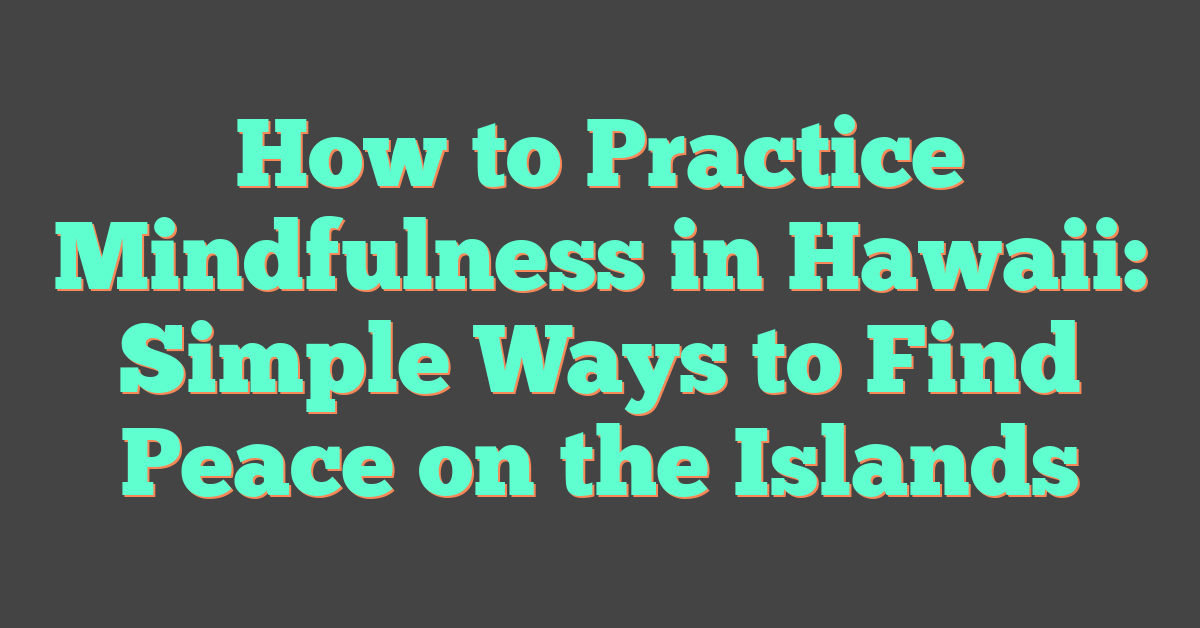When I first arrived in Hawaii, I felt calm just by being near the ocean, mountains, and tropical air. The beautiful environment makes it easy for me to slow down and notice what’s happening right now.

In Hawaii, I practice mindfulness by focusing on my breath and listening to the sounds of nature. I also notice small details, like the feel of warm sand or the colors of a sunset.

Mindfulness is simple and doesn’t require much time. Even a few minutes each day help me feel more relaxed and less stressed.
I often walk along the beach or sit quietly under a tree to start being more mindful. Local groups share mindfulness tips and exercises that I find helpful.
Living in Hawaii gives me many chances to practice mindfulness every day. These moments help me appreciate life and handle stress.
Understanding Mindfulness
Mindfulness helps me focus and feel calmer. I practice it every day to support my mental health and reduce anxiety.
What Is Mindfulness?
Mindfulness means paying attention to the present moment without judgment. I notice my thoughts, feelings, and actions as they are, not as I wish them to be.
I use my breathing, senses, and body to bring myself back when my mind wanders. Practicing mindfulness does not require special equipment.
I can be mindful while walking, eating, or even washing dishes. It’s about being aware on purpose, in a gentle way.
In Hawaii, mindfulness often connects with the spirit of aloha, inviting me to approach life with kindness and acceptance.
Benefits for Mental Health
When I practice mindfulness often, I notice changes in my mood. Regular mindfulness exercises help lower anxiety and boost my focus.
By slowing down and checking in with myself, I become more aware of my feelings before I react. Many people also use mindfulness to improve sleep and reduce symptoms of depression.
A few minutes each day can create a calmer mind and a more positive outlook. Practicing mindfulness in nature or with a group, as some local communities in Hawaii suggest, helps me feel more connected and supported.
How Mindfulness Reduces Stress
Mindfulness teaches me to pause and breathe when I feel overwhelmed. When I pay attention to my breath or body sensations, my heart rate slows and my muscles relax.
This gives my mind a break from constant worries. Guided meditation and quick mindfulness exercises can trigger the body’s natural relaxation response.
Simple activities, like focusing on sounds or practicing a loving-kindness meditation, help relieve tension. In Hawaii, many people use these mindfulness practices to reduce stress, which brings a greater sense of peace and balance.
Why Practice Mindfulness in Hawaii?

Practicing mindfulness in Hawaii feels unique to me. The islands offer peaceful settings, deep cultural traditions, and a special connection with nature that helps me find calm.
Unique Healing Aspects of the Islands
Hawaii gives me a healing energy as soon as I arrive. The islands have a long history of people coming here to restore their health and minds.
Many natural sites, like beaches, volcanic landscapes, and tropical gardens, invite a deep sense of calm. When I practice mindfulness here, the sights, sounds, and smells help clear my mind.
Breathing in the fresh ocean air or listening to gentle waves reduces my stress. Organizations like Mindful Hawaii support these healing experiences.
I also find mindfulness retreats and workshops across Hawaii. Many use the natural setting and traditional Hawaiian practices to create a calming experience.
Connection with Hawaiian Nature
When I practice mindfulness outdoors in Hawaii, I quickly feel close to nature. Tall palm trees, gentle breezes, and ocean waves help bring me into the moment.
Even walking through a garden or sitting by the water feels peaceful and grounding. I often use simple exercises like deep breathing while watching the sunset or listening to birds.
These small actions help me slow down and notice my surroundings. Hawaii’s warm climate and beautiful scenery make it easy for me to practice mindfulness outside all year.
Mindfulness can happen during activities like yoga or walking meditations. These practices are common in Hawaii and suggested by places like Wellness Counseling Hawaii, where people use the land’s beauty to find calm.
The Spirit of Aloha and Acceptance
One thing I notice about practicing mindfulness in Hawaii is the deep sense of aloha. Aloha means love, peace, and acceptance, not just hello or goodbye.
This spirit shapes how people treat each other. Embracing aloha helps me become more patient and open-minded.
If I bring judgment or stress into my practice, the local culture reminds me to let go. I try to accept each moment, and myself, just as we are.
Many organizations offer workshops based on mindfulness and aloha, helping people learn to deal with life’s challenges calmly. These lessons help me build stronger relationships and feel more at peace.
Foundational Mindfulness Techniques
When I start to practice mindfulness, I use methods that help me feel calm, centered, and aware. Simple breathing exercises, basic meditation, and everyday activities help me grow my skills.
Breathing Exercises for Calm
I calm my mind with breathing exercises. I sit comfortably, close my eyes, and slowly breathe in through my nose.
I count to four, hold my breath for a moment, and then exhale slowly. This helps relax my body and quiet my thoughts.
Sometimes, I try deep belly breathing by placing my hand on my stomach and feeling it rise as I breathe in. This reminds me to use my diaphragm for a more calming breath.
If I feel stressed, I focus on the sensation of air moving in and out. Guided breathing is simple but helps me refocus anywhere.
Focusing on my breath is a key step to managing stress, as Hawaii Pacific Health recommends.
Practicing Mindfulness Meditation
I set aside a few minutes each day for mindfulness meditation. I find a quiet spot, sit with a straight back, and gently close my eyes.
I pay attention to my breath and let each inhale and exhale come naturally. If my mind wanders, I gently bring my focus back to my breathing.
I try not to judge myself for distractions. Meditation is about noticing what’s happening in my mind right now.
Sometimes, I use short guided meditations from apps or videos. Other times, I sit in silence.
Over time, meditating regularly helps me handle strong emotions and feel more present. Practicing in a group or classroom can increase focus and connection, as seen in Hawaii classrooms.
Awareness Building Activities
I build awareness by paying attention to simple daily activities. When I walk, I notice the feeling of my feet on the ground and the sounds around me.
Eating mindfully is another good practice. I take small bites, chew slowly, and notice the taste and texture.
I put away my phone and focus only on my meal. Grounding activities like feeling sand at the beach, smelling flowers, or listening to birds help me stay present.
Locals often use such practices to support mental health, as suggested by Wellness Counseling Hawaii.
I remind myself that awareness can fit into almost anything I do each day.
Developing Compassion and Self-Kindness
To grow compassion, I practice being gentle with myself and others. When I make mistakes, I talk to myself with care, just like I would comfort a friend.
I might repeat kind phrases, such as, “May I be patient with myself,” or “May I feel peace.” I try to notice when I’m being hard on myself.
Instead, I pause, breathe, and remember that everyone faces challenges. Self-compassion takes time, but each step matters.
To show kindness to others, I practice active listening and smiling. In Hawaiian tradition, sharing aloha means listening with respect and offering help without expecting anything in return.
These simple actions help me build better relationships and feel more connected to my community. Everyday kindness starts with how I treat myself and spreads out to those around me.
Mindfulness Activities in Hawaii’s Natural Settings
Hawaii has many peaceful places where I connect deeply with nature. Being outside helps me pay attention to my senses and relax in unique ways.
Mindful Hiking on Island Trails
When I hike on Hawaii’s island trails, I notice how my breath changes with every step. The fresh air and the scent of tropical flowers help me clear my mind.
Lush valleys on the Big Island and the cliffs of Kauai offer unique sounds, from birds to distant ocean waves. Each walk feels special because of these natural details.
I walk slowly and focus on the feeling of the ground beneath my shoes. I pause sometimes, close my eyes, and listen to the world around me.
On misty mornings in the forest, I feel peaceful and connected to nature. Some retreats in Hawaii guide mindful walks in beautiful places like Kona Cloud Forest Sanctuary.
Tips for Mindful Hiking:
- Limit distractions, such as turning off my phone.
- Focus on my breathing.
- Pause to observe sounds, colors, and textures.
Yoga by the Ocean
Practicing yoga by the ocean in Hawaii calms me. The sound of the waves sets a slow rhythm for my movements and helps me focus on each breath.
I often unroll my mat on soft sand or grass along the shore and stretch under the sky. Many beaches offer early-morning or sunset yoga classes for all levels.
Sometimes, I practice alone, letting the cool breeze and sun keep me present. The scent of saltwater and the soothing sights and sounds help me relax.
Each pose helps me feel grounded and centered. If I want company, I can join meditation and wellness retreats across Hawaii.
Common Poses for Relaxation:
- Child’s Pose
- Downward Dog
- Seated Forward Fold
Walking Meditation in Gardens
I enjoy walking slowly through quiet gardens and paying attention to each step. Hawaii has many public gardens filled with native plants, peaceful paths, and shady trees.
When I practice walking meditation, I move silently and match my breath to my pace. I focus on small details like bright flowers, flowing water, or bamboo leaves rustling in the breeze.
This close observation keeps me present. Some retreats and local mindfulness organizations, such as Mindful Hawaii, offer space and time for silent walking and reflection.
Benefits of Garden Meditation:
- Reduces stress
- Boosts happiness
- Brings a sense of inner balance
Practicing by the Bodhi Tree
Spending time under a bodhi tree feels peaceful and meaningful. The bodhi tree connects to meditation and enlightenment.
Some gardens and temples in Hawaii have bodhi trees open to visitors for quiet sitting or meditation. I sit beneath the leaves, focus on my breath, and let my thoughts settle.
The cool shade and gentle movement of the leaves comfort me. Practicing by the bodhi tree reminds me to let go of busy thoughts and return to the present.
Ways I Practice Mindfulness Here:
- Breathing exercises
- Guided meditation
- Silent sitting
Integrating Mindfulness into Daily Life in Hawaii
Staying present during busy days in Hawaii helps me manage stress and feel calmer. Simple habits make it easier to bring mindfulness into my routines.
Creating a Relaxation Routine
Setting aside time for relaxation each day supports my mind and body. Even five minutes of deep breathing, listening to sounds, or gentle yoga can help.
Walking along the beach or sitting in a quiet garden allows me to pause and focus on the present. Here are easy steps I use to practice mindfulness at home:
- Deep Breathing: Inhale slowly, notice the air, and exhale gently.
- Mindful Eating: Savor each bite, notice textures, and eat without distractions.
- Body Scan Meditation: Focus on different body parts, starting from my toes to my head.
When I practice these regularly, I feel more relaxed and better able to handle stress. I also visit local mindfulness groups like Mindful Hawaii for support.
Maintaining Mindfulness at Work or School
Mindfulness helps me when my day gets busy at work or school. I focus on one task at a time and try not to rush.
If I get distracted, I bring my attention back to what I am doing, even if it is just reading an email or talking with a coworker. When I need a break, I step outside or look out the window for a few moments.
This short pause helps me reset and return to work with a clearer mind. Sometimes, I use reminders or set aside specific times for quick breathing exercises or stretching.
Mindful breathing, short walks, or noticing the sounds and smells around me help lower my tension and keep me focused. Mindfulness also encourages me to listen carefully and communicate better with others.
Coping with Anxiety and Stress
Living in Hawaii does not mean I am free from anxiety or stress. When I feel overwhelmed, I use short breathing exercises or take a break to check in with my feelings.
These practices calm my body and mind so I can think more clearly. I try to notice what triggers my anxiety and write down my thoughts in a journal.
When my mind races, I focus on my breath or follow a short meditation. Practicing these habits helps me manage tough days.
If I want more support, I talk to a therapist who teaches mindfulness-based techniques in Hawaii. I remind myself that practicing mindfulness is a skill I improve with time.
Building Community Through Mindfulness

Connecting with others who value mindfulness helps me feel supported and inspired. Sharing my practice through meditation, yoga, or acts of compassion makes mindfulness more meaningful.
Finding Local Meditation Groups
Joining a meditation group in Hawaii helps me feel less alone. I look for groups that offer both in-person and online options.
In Honolulu, the Honolulu Mindfulness Community hosts weekly gatherings with guided meditation and group discussions. Meditating as a group builds a sense of support and shared purpose.
I enjoy learning different meditation styles and hearing about others’ experiences. Many groups welcome beginners and offer short instructions to help everyone feel comfortable.
Local groups foster compassion for myself and everyone present. Seeing familiar faces reminds me that mindfulness can be a shared practice.
Participating in Community Yoga
Community yoga classes in Hawaii welcome everyone. Many parks and wellness centers offer yoga sessions for all skill levels.
Practicing yoga with others helps me connect my mind and body. Yoga classes that focus on mindfulness and breathing deepen my awareness.
These classes often offer modifications, so I don’t feel left out if I’m just starting. I notice more patience and kindness in myself and those around me after class.
Shared yoga practice encourages us to support each other and celebrate progress together. Centers like The Practice Center in Hawaii sometimes include mindfulness and personal growth workshops with yoga, building a compassionate community.
Supporting Each Other on the Journey
A community lets me lean on others when mindfulness feels tough. When I share tips and personal stories, the challenges feel lighter.
Simple acts, like checking in with a meditation buddy or offering a kind word, help me stick with my practice. I often join regular events, such as mindfulness walks, group check-ins, or workshops, to get more chances to learn and grow with others.
These events encourage us to practice compassion for ourselves and for others. When I give and receive support, I build lasting friendships and deepen my understanding of mindfulness.
If I want more ideas or want to join events focused on building resilience through mindfulness, I look for resources that suggest community mindfulness events and workshops. Focusing on others reminds me that mindfulness is about being present for myself and my community.




